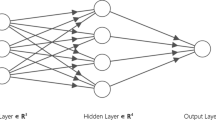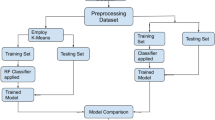Abstract
Fuzzy c-means (FCM) clustering method is used for performing the task of clustering. This method is the most widely used among various clustering techniques. However, it gets easily stuck in the local optima. whale optimization algorithm (WOA) is a stochastic global optimization algorithm, which is used to find out global optima of a provided dataset. The WOA is further modified to achieve better global optimum. In this paper, a fuzzy clustering method has been proposed by using the strengths of both modified whale optimization algorithm (MWOA) and FCM. The effectiveness of the proposed clustering technique is evaluated by considering some of the well-known existing metrics. The proposed hybrid clustering method based on MWOA is employed as an under sampling method to optimize the cluster centroids in the proposed automobile insurance fraud detection system (AIFDS). In the AIFDS, first the majority sample data set is trimmed by removing the outliers using proposed fuzzy clustering method, and then the modified dataset is undergone with some advanced classifiers such as CATBoost, XGBoost, Random Forest, LightGBM and Decision Tree. The classifiers are evaluated by measuring the performance parameters such as sensitivity, specificity and accuracy. The proposed AIFDS consisting of fuzzy clustering based on MWOA and CATBoost performs better than other compared methods.


Similar content being viewed by others
References
Wang JH, Liao YL, Tsai TM, Hung G (2006) Technology-based financial frauds in Taiwan: issues and approaches. In: IEEE international conference on systems, man and cybernetics, 2006. SMC’06, vol 2. IEEE, pp 1120–1124
Supraja K, Saritha SJ (2017) Robust fuzzy rule based technique to detect frauds in vehicle insurance. In: 2017 International conference on energy, communication, data analytics and soft computing (ICECDS). IEEE, pp 3734–3739
Australia: Insurance (2016) Australia: insurance fraud costs us 1.5 bln annually. http://www.insurancefraud.org/IFNS-detail.htm?key=22516. Accessed 10 Sept 2018
Cutting Corners (2015) Cutting corners to get cheaper motor insurance backfiring on thousands of motorists warns the abi. https://www.insurancefraudbureau.org/media-centre/news/2015/cutting-corners-to-getcheaper-motor-insurance-backfiring-on-thousands-of-motorists-warns-the-abi/. Accessed 10 Sept 2018
Ngai E, Hu Y, Wong Y, Chen Y, Sun X (2011) The application of data mining techniques in financial fraud detection: a classification framework and an academic review of literature. Decis Support Syst 50(3):559–569
Šubelj L, Furlan Š, Bajec M (2011) An expert system for detecting automobile insurance fraud using social network analysis. Expert Syst Appl 38(1):1039–1052
Phua C, Alahakoon D, Lee V (2004) Minority report in fraud detection: classification of skewed data. ACM Sigkdd Explor Newslett 6(1):50–59
Bermúdez L, Pérez JM, Ayuso M, Gómez E, Vázquez FJ (2008) A Bayesian dichotomous model with asymmetric link for fraud in insurance. Insur Math Econ 42(2):779–786
Xu W, Wang S, Zhang D, Yang B (2011) Random rough subspace based neural network ensemble for insurance fraud detection. In: 2011 Fourth international joint conference on computational sciences and optimization (CSO). IEEE, pp 1276–1280
Tao H, Zhixin L, Xiaodong S (2012) Insurance fraud identification research based on fuzzy support vector machine with dual membership. In: 2012 International conference on information management, innovation management and industrial engineering (ICIII), vol 3. IEEE, pp 457–460
Pears R, Finlay J, Connor AM (2014) Synthetic minority over-sampling technique (SMOTE) for predicting software build outcomes. arXiv preprint arXiv:1407.2330
Sundarkumar GG, Ravi V (2015) A novel hybrid undersampling method for mining unbalanced datasets in banking and insurance. Eng Appl Artif Intell 37:368–377
Subudhi S, Panigrahi S (2017) Use of optimized fuzzy c-means clustering and supervised classifiers for automobile insurance fraud detection. J King Saud Univ Comput Inf Sci. https://doi.org/10.1016/j.jksuci.2017.09.010
Lee YJ, Yeh YR, Wang YCF (2013) Anomaly detection via online oversampling principal component analysis. IEEE Trans Knowl Data Eng 25(7):1460–1470
Bezdek JC, Ehrlich R, Full W (1984) FCM: the fuzzy c-means clustering algorithm. Comput Geosci 10(2–3):191–203
Taherdangkoo M, Bagheri MH (2013) A powerful hybrid clustering method based on modified stem cells and fuzzy c-means algorithms. Eng Appl Artif Intell 26(5–6):1493–1502
Esmin AA, Coelho RA, Matwin S (2015) A review on particle swarm optimization algorithm and its variants to clustering high-dimensional data. Artif Intell Rev 44(1):23–45
Ji Z, Xia Y, Sun Q, Cao G (2014) Interval-valued possibilistic fuzzy c-means clustering algorithm. Fuzzy Sets Syst 253:138–156
Hassanzadeh T, Meybodi MR (2012). A new hybrid approach for data clustering using firefly algorithm and K-means. In: 2012 16th CSI international symposium on artificial intelligence and signal processing (AISP). IEEE, pp 007–011
Niknam T, Firouzi BB, Nayeripour M (2008) An efficient hybrid evolutionary algorithm for cluster analysis. World Appl Sci J 4:300–307
Kao YT, Zahara E, Kao IW (2008) A hybridized approach to data clustering. Expert Syst Appl 34(3):1754–1762
Murthy CA, Chowdhury N (1996) In search of optimal clusters using genetic algorithms. Pattern Recogn Lett 17(8):825–832
Bandyopadhyay S, Maulik U (2002) An evolutionary technique based on K-means algorithm for optimal clustering in RN. Inf Sci 146(1–4):221–237
Alswaitti M, Albughdadi M, Isa NAM (2018) Density-based particle swarm optimization algorithm for data clustering. Expert Syst Appl 91:170–186
Majhi SK, Biswal S (2018) Optimal cluster analysis using hybrid K-Means and Ant Lion Optimizer. Karbala Int J Mod Sci 4(4):347–360
Majhi SK, Bhatachharya S, Pradhan R, Biswal S (2019) Fuzzy clustering using salp swarm algorithm for automobile insurance fraud detection. J Intell Fuzzy Syst 36(3):2333–2344
Pandey AC, Rajpoot DS (2019) Spam review detection using spiral cuckoo search clustering method. Evolut Intell 12(2):147–164
Benmessahel I, Xie K, Chellal M, Semong T (2019) A new evolutionary neural networks based on intrusion detection systems using locust swarm optimization. Evolut Intell 12(2):131–146
Dunn JC (1973) A fuzzy relative of the ISODATA process and its use in detecting compact well-separated clusters. J Cybern 3(3):32–57. https://doi.org/10.1080/01969727308546046
Bezdek JC (1981) Objective function clustering. In: Bezdek James C (ed) Pattern recognition with fuzzy objective function algorithms. Springer, Boston, pp 43–93
Mirjalili S, Lewis A (2016) The whale optimization algorithm. Adv Eng Softw 95:51–67
Dua D, Graff C (2019) UCI machine learning repository. School of Information and Computer Science, University of California, Irvine, CA. http://archive.ics.uci.edu/ml
Chen S, Xu Z, Tang Y (2014) A hybrid clustering algorithm based on fuzzy c-means and improved particle swarm optimization. Arab J Sci Eng 39(12):8875–8887
Friedman M (1937) The use of ranks to avoid the assumption of normality implicit in the analysis of variance. J Am Stat Assoc 32(200):675–701
Friedman M (1940) A comparison of alternative tests of significance for the problem of m rankings. Ann Math Stat 11(1):86–92
Holm S (1979) A simple sequentially rejective multiple test procedure. Scand J Stat 6:65–70
Ke G, Meng Q, Finley T, Wang T, Chen W, Ma W, Ye Q, Liu TY (2017) Lightgbm: a highly efficient gradient boosting decision tree. In: Advances in neural information processing systems, pp 3146–3154
Swain PH, Hauska H (1977) The decision tree classifier: design and potential. IEEE Trans Geosci Electron 15(3):142–147
Dorogush AV, Ershov V, Gulin A (2018) CatBoost: gradient boosting with categorical features support. arXiv preprint arXiv:1810.11363
Breiman L (2001) Random Forests. Mach Learn 45(1):5–32
Chen T, Guestrin C (2016) Xgboost: a scalable tree boosting system. In: Proceedings of the 22nd acmsigkdd international conference on knowledge discovery and data mining. ACM, pp 785–794
Tukey JW (1977) Exploratory data analysis. Addison-Wesley Publishing Company, Reading, MA
Author information
Authors and Affiliations
Corresponding author
Rights and permissions
About this article
Cite this article
Majhi, S.K. Fuzzy clustering algorithm based on modified whale optimization algorithm for automobile insurance fraud detection. Evol. Intel. 14, 35–46 (2021). https://doi.org/10.1007/s12065-019-00260-3
Received:
Revised:
Accepted:
Published:
Issue Date:
DOI: https://doi.org/10.1007/s12065-019-00260-3




